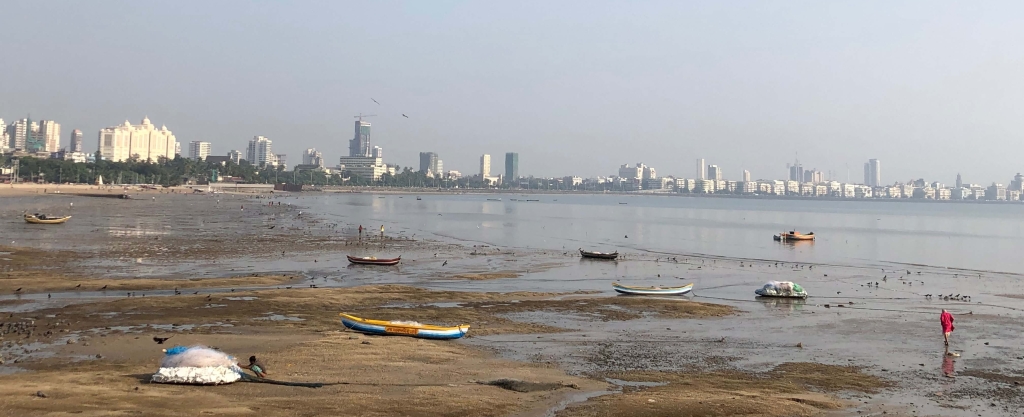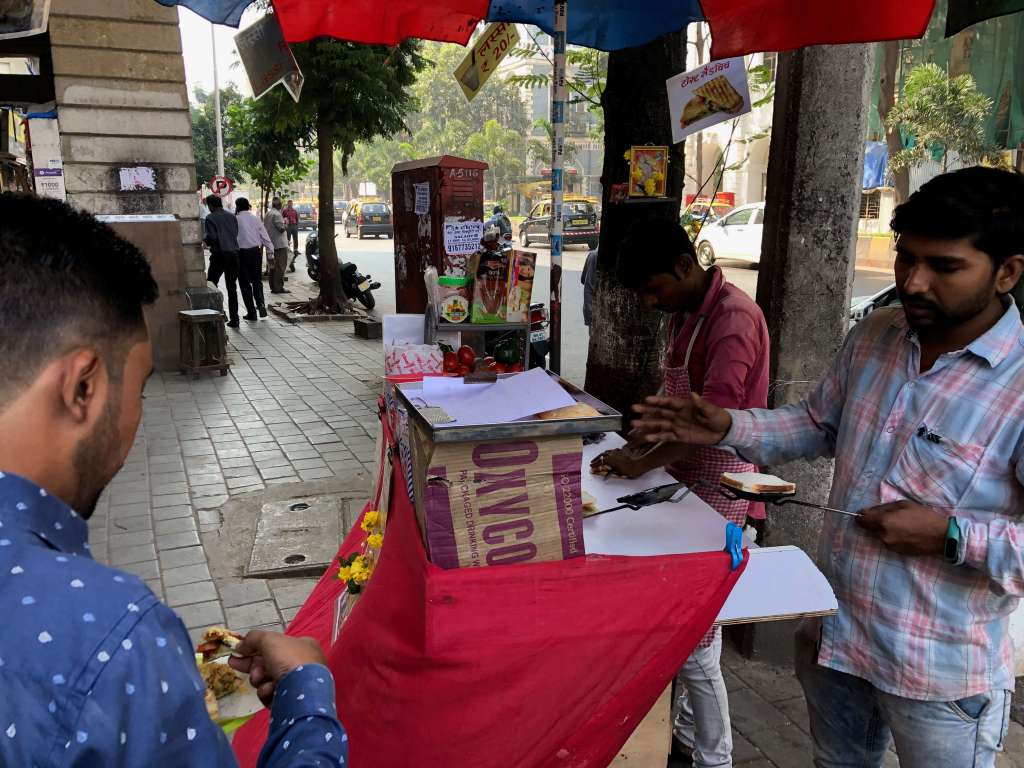

We were crossing the Sea Link bridge as dawn began to diffuse through the haze and the skyline loomed into view – dozens of cranes perched atop half-built towers rising up behind the shanties of Worli. This early in the morning, it seemed, most Mumbaikars were still asleep, and our Uber traversed the length of the city with relative ease.
We arrived in Colaba, the neighborhood that is at once the heart of Mumbai and its geographic extremity. The streets were still sleepy as some vendors pushed their little kitchens on wheels along the uneven pavement in search of a place to set up shop, and others began setting out boxes of produce. One vendor, eager to show off the day’s selection of fruit, found us to be easy customers – we paid him three hundred rupees and walked away with several pounds of tropical treats before ducking into the Leopold Cafe for breakfast. I instinctively made to order coffee before remembering that I was in India, and ordered masala chai instead.
The purpose of making this early-morning journey down to Colaba was to meet our guide, Balaji, who would introduce us to his city’s colonial heritage. Portuguese colonists first arrived here in the early sixteenth century and established trading outposts and Catholic churches in the island villages surrounding the natural harbor. The islands were later gifted to the British monarch who in turn leased them to the East India Company, which built a fort, established a university, and transformed Bombay into one of the most important trading hubs in the world. In fact, when the Europeans found the warring Confederate States of America to be an unreliable supplier of cotton, Bombay stepped in to pick up the slack. After the British gained nearly complete control of India, the need for a defensive fortress in Bombay diminished, so the walls were torn down to unleash the natural growth of the new city.
But India is proudly independent now, so when Balaji took us to the first stop on our tour, we found ourselves standing before the monumental Gateway of India, through which the last of the colonists departed on a historic day seven decades ago. On a typical day, hundreds of visitors mill about the plaza, taking selfies and watching the boats go by. Today, however, the view of the Gateway was obscured by a stage and rows of bleachers in preparation for a somber commemoration later in the day. On November 26, Mumbai remembers not the British who left in 1948, but the terrorists who arrived in 2008, executing a series of bombings and shootings in prominent locations including the restaurant we had just emerged from, the ornate gothic train station through which thousands of commuters would soon be streaming, and the extravagant hotel next to the Gateway where hostages were held for three days.
By the time we parted with Balaji, Colaba had come to life. The boxes of produce had transformed into meticulously symmetrical tiered displays. The carts had sprouted umbrellas that cast shade over the chefs who tirelessly clamped one Bombay sandwich after another between hot tongs before passing them on to the commuters now flooding the streets. Well-dressed lawyers slowed their pace long enough to enjoy an obligatory tea break at the the little shacks churning out endless cups of chai, some of which was packed up for delivery to the nearby businesses. As for me and my friends, we sought out an air conditioned restaurant to escape the midday sun.
A TV hung un the corner of the restaurant, and whatever the reporter was talking about, the afternoon found us inadvertently in the midst of, as we loitered on a narrow street lined by police. The road led through a partially-open gate flanked by neoclassical columns and security cameras. SUVs lined up to enter, but not all were granted access. Reporters clustered in the shade of trees with one eye on their cameras and the other on the proceedings behind them. Meanwhile, three confused tourists stood awkwardly by, hoping a tour guide would materialize from the commotion.
It turned out that 115 million people were tuned in to what was happening here, though none quite knew what was going to happen. What was clear to all was that the government was going through an unexpected turnover. Mumbai is the capital of Maharashtra, India’s second-largest state, and the people had recently cast ballots that significantly disrupted the balance of power among the numerous political parties. A scramble to establish a new working government ensued. The catch is that in Maharashtrian politics, if you are an alliance of parties and you want to form a government, you must present your proposal to the governor who must approve it, before any of your allies turn on you in the middle of the night and attempt to form a different government behind your back with the intervention of the prime minister. Incidentally, the gate where the confused tourists were waiting to begin their tour was the governor’s house, the literal finish line in this political backstabbing race.
The tour guide, more in tune with local state politics than we were, considered avoiding the place altogether, but did show up eventually after realizing we were probably already there. He briefed us on what may or may not have been about to happen, checked his phone for any news, and confirmed that no one had a clue. That non-reassurance was accompanied by some possibly exaggerated claims about the real estate value of the governor’s house, which finally brought us around to the reason we had left the air conditioning to come to this place: to learn about Malabar Hill, one of Mumbai’s wealthiest neighborhoods.
Although the most expensive private home in the world is just down the street, we would actually be learning about Malabar Hill’s other distinction, being one of the oldest neighborhoods in Mumbai. Our guide led us a few steps away from the commotion, and soon we were wandering through the ancient streets. We arrived at the edge of a rectangular spring-fed reservoir lined with steps on all sides to facilitate access for ritual cleansing. The reservoir was already four hundred years old when the first European colonists arrived, and it was built to service an even older temple that is a popular site for religious pilgrimage on the full moon. Behind the trees that surround the reservoir, the decorated vimana towers of dozens of other temples peek up, reflecting the evening sunlight and emphasizing the significance of this place for Hindus. For the people who have maintained these temples for generations, the reservoir forms the center of a close-knit and traditional community that persists despite the rapid urbanization all around them.

Our day of sightseeing ended on a rooftop looking out over the glittering skyline and the bright waterfront arc of Marine Drive. Even after two visits, I feel I’ve barely scratched the surface of Mumbai. I’ve gotten a glimpse of the city’s history, its culture, its food, and its current events (not to mention the fact that many of my colleagues at work are from here). But Mumbai is like the NYC and the LA of India rolled into one, so I suspect there will always be something new to discover every time I return.





Great report Aaron! Very into!
LikeLiked by 2 people
Very interesting!
LikeLiked by 2 people